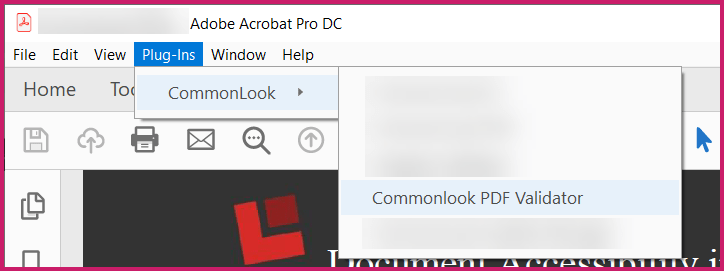To check if a PDF document is accessible, you need software like CommonLook’s PDF Validator, which tests the PDF against accessibility standards like Section 508, WCAG 2.0 AA, PDF/UA and HHS standards. PDF Validator generates a certification report that tells you whether your PDF document is accessible or not.
Did you know that a blind man sued Domino’s pizza because the latter’s website was inaccessible to the blind? Similarly, a blind woman filed a lawsuit against Beyonce’s official website because it violated the Americans With Disabilities Act by denying visually impaired users equal access to products and services offered on the site.
The web is filled with millions upon millions of digital documents, websites and apps. It is a shame that over 90 percent of all web content is inaccessible to the disabled, which comprise 15% of the world’s population. Shouldn’t they be able to access digital information too?
Why do you need to make a PDF accessible?
PDF documents are everywhere. In fact, PDF documents comprise a remarkable portion of all digital files – whether it’s a bank statement, digital invoice, job posting, product brochure or application form.
Those with visual disabilities do not “read” PDFs the same way sighted people do. While someone with normal vision can see the contents of a PDF document, a blind person needs to print it in braille or hear it. A visually impaired individual can read these documents with assistive technologies like braille printers and screen readers (such as JAWS or NVDA), which provide their visually impaired users with braille printouts or text-to-speech output.
To individuals with normal vision and no color-blindness, an inaccessible PDF may look the same as an accessible PDF; this is why determining whether a PDF document is accessible just by looking at it is a challenge. If your PDF is not coded correctly, then people with visual disabilities cannot read it. In addition to that, your organization may be liable to accessibility lawsuits under the Americans with Disabilities Act (ADA).
How to check if a PDF is accessible?
To ensure that your PDF is accessible, you need a special tool that tests your PDF document for various accessibility standards (such as Section 508, WCAG 2.0 AA, etc.). CommonLook PDF Validator is a powerful tool that lets you do just that.
PDF Validator tests and verifies PDF documents. It is a free plugin for Adobe Acrobat Pro or DC (note that Validator is not a standalone software; i.e., it works within Adobe Acrobat software’s environment).
Download PDF Validator for free
The thing that sets CommonLook PDF Validator apart from any other tool of this kind is that tests against Section 508, WCAG 2.0 AA, PDF/UA, and HHS standards. Unlike other PDF verification products, CommonLook PDF Validator provides users with a certification report for each tested document. Communications and compliance specialists can rest assured that their PDFs are compliant with accessibility standards. With other verification products, documents can sometimes pass the tests, but still not be accessible and compliant.
Once you download and install PDF Validator, what’s next?
Open the PDF in Adobe Acrobat. In the toolbar at the top of the Acrobat window, choose Plug-Ins, then CommonLook, and then CommonLook PDF Validator.

This will open the PDF file in CommonLook PDF Validator. After that, you need to use the Standards panel to test a document for accessibility standards.
CommonLook PDF validator provides two kinds of verification on any PDF document:
Structural – a “structural” check will test the file for issues like (but not limited to) proper structure of lists, tables and table of contents. It also verifies that hyperlinks are not broken and tags are not empty.
Accessibility – running an “Accessibility” verification will test the document against one (or more) specific accessibility standards like Section 508 from 2001, WCAG 2.0, PDF/UA, HHS (the original standard), HHS 2018 and WCAG 2.1.
What to do if your PDF is NOT accessible?
It is likely that after you check your PDF file’s accessibility using PDF Validator, you will find out that your PDF is not accessible. What then? You have two choices:
- Make your PDF file accessible using an accessibility software
- Get professional help to get your PDFs remediated, especially if you have a large number of inaccessible PDF files.
Using accessibility software to remediate PDFs
If you have inaccessible PDF document(s) and you want to make them accessible, you can use CommonLook PDF. CommonLook PDF provides an all-in-one environment to test, remediate and verify documents. Listed in the W3C’s PDF Techniques for WCAG 2.0, CommonLook PDF is loaded with powerful features to accelerate the remediation process. It provides faster and more efficient results than Adobe Acrobat alone.
CommonLook PDF enables teams to produce high quality remediated documents, quickly and efficiently. It simplifies and expedites remediation tasks while injecting a methodology into the remediation process. This functionally-rich solution is the premier choice for industry professionals concerned with ensuring compliance with accessibility standards.
If you are interested in using CommonLook PDF to make your PDF files accessible, you can request a demo from this page.
Getting professional help to remediate your PDFs
Allyant’s Document Verification and Remediation services provide an accurate, comprehensive and cost-effective way to achieve Section 508, WCAG 2.0, PDF/UA 1.0 and HHS compliance for PDFs that are public-facing, frequently accessed, or for large volumes of PDF documents and forms. You provide CommonLook with the PDF files you want to be verified and repaired for accessibility. We provide you with a fixed, firm quote to ensure their compliance. All you need to do is let us know what your requirements are.
That’s how simple it is to comprehensively remediate your PDF documents and make them accessible to everyone.

